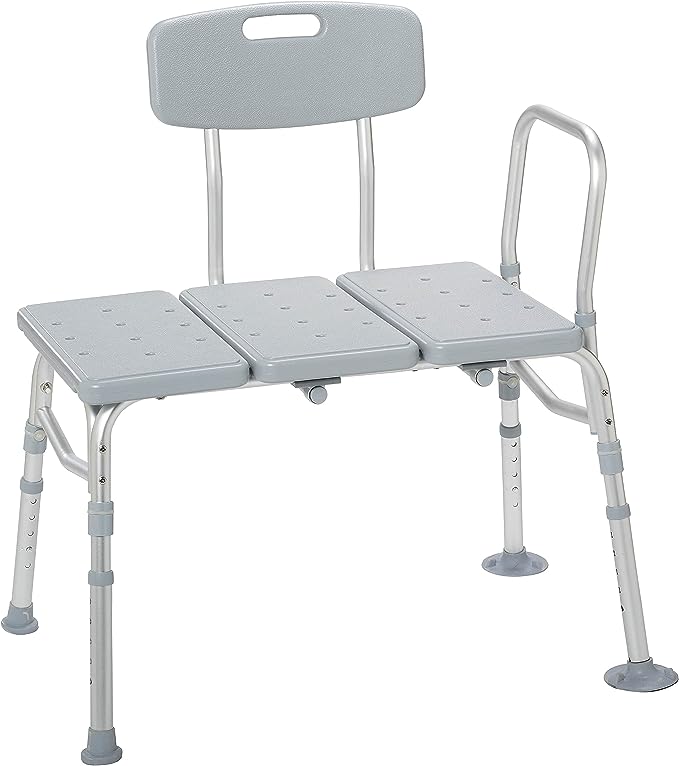Dementia Bath Guide
Bathing can be one of the biggest challenges in dementia care. This guide explains why those with dementia may resist bathing, offers tips to ease the process, and suggests items to make bath time safer and more comfortable for both of you.

Why do those with Dementia dislike bathing?
Bathing resistance often begins in the middle stages of dementia, and it can stem from a mix of fears, discomforts, and sensitivities, including:
- Fear of Water: Changes in depth perception can make it hard to judge water depth, making baths or showers appear frightening. Anxiety about falling also plays a role, as stepping in and out can be tricky for those with balance issues.
- Emotional Discomfort: Bathing often feels too personal, especially for someone who is used to privacy. A person with dementia might not recognize you or might feel embarrassed, thinking of you as a stranger or family member, seeing them undressed.
- Physical Sensitivities: Physical pain, cold sensitivity, or sensitive skin can make bathing uncomfortable. The noise of running water or the prickly sensation of shower spray can also cause agitation.
Getting Bath Compliance: Tips to Ease the Process
- Routine is Key: Build a bath routine early on, ideally matching their current preferences. For example, if they’re used to a morning shower, keep it that way.
- Gentle Language: Certain words can be triggering. Instead of saying “bath” or “shower,” try phrases like “freshen up,” “clean up,” or “let’s wash up.” Saying “we” instead of “you” can make it feel like you’re doing this together.
- Little Incentives: Small prompts can help motivate them to bathe. For example, you could say:
- “Let’s clean up before breakfast.”
- “We’re expecting visitors later.”
- “We’ll feel so much better after we freshen up!”
Making Bath Time Enjoyable
Think of creating a spa-like experience:
- Set the Scene: Keep the room warm, play soft music, use pleasant scents, and offer a soft robe for afterward.
- Stay Calm and Positive: Speak softly, smile, and move gently.
Dementia bathing tips for success
- Go slowly and allow plenty of time.
- Give simple step-by-step instructions with two or three words.
- Keep them involved, and have them wash what they can
- Praise them for each small step.
- If they’re nervous, keep a washcloth in their hands; it keeps them busy and focused.
- Say what you are going to do before you do it to prevent startling them
- Only uncover one body area at a time for dignity, especially if you’re doing a bed bath.
- Have everything within reach—soap, washcloths, and towels.
- Place a towel over the cold toilet seat to sit on
- If bathing becomes too challenging, consider having a home aide help a few times a week.
Gather all the necessary supplies for the Dementia bath before you attempt to get them in the bathroom. Include towels, washcloths, soap, shampoo, clean clothes, and underwear/briefs/pull-ups. This will help the process go smoother and prevent the need to leave the room during the bath.

The recommended bathing for someone with Dementia should consist of daily washing of the face and their privates. At least twice a week, they should have some type of bath/shower if possible.
helpful equipment for Dementia Bathing
Grab Bars and Non-Slip Mats:
Grab bars and non-slip mats are vital safety tools for preventing falls, particularly for individuals with dementia who may feel unsteady or are prone to balance issues. Installing grab bars in key areas—such as beside the toilet, along the bathtub wall, and within the shower stall—gives your loved one stable surfaces to hold onto as they move in and out of the bathing area.
Similarly, non-slip mats in the shower, tub, and bathroom floor prevent slipping on wet surfaces, adding an extra layer of protection.
You can find this grab bar HERE.
Use a shower chair/ Tub Transfer Bench:
Overhead showers and deep bathtubs can be overwhelming and frightening.
Using a shower chair will make them feel more secure and help prevent falls.
Showers are the preferred method for a Dementia bath for almost all caregivers. Bathtubs become difficult to get in and out, especially if they are weak and unable to follow commands very well.
There are several types of shower chairs on the market. The tub transfer bench to work the best for homes with a tub/shower combo. It allows them to sit on the bench before getting into the tub and slide over.
You can find this Tub Transfer Bench HERE.
Invest in a handheld shower sprayer!
A handheld sprayer can be less intimidating than an overhead shower, as you can better control water flow, keep it out of their face, and reduce noise.
This is the type of showerhead I recommend. It works well for the household. The rest of the family has a regular shower, and the handheld sprayer is easy to lift off for the Dementia bath.
You can find this handheld sprayer HERE.
types of Dementia baths
Toilet washup: is easy and often used when the patient is sitting on the toilet. It is relatively easy to get to all parts of the body. Guiding them to wash their face and body parts they can reach keeps them involved.
Tub baths: Can work initially, though it becomes harder as mobility declines.
Shower: Often the preferred method, especially with a shower chair.
Bath wipes: A gentle option, especially if they’re uncomfortable with water. Most hospitals now use bath wipes.
Bed bath: When they’re unable to leave bed, you can use water or bath wipes. The wipes are less messy but more costly.
Alternate body part: Focus on one area each day for a complete clean over a week.
Late-Stage Bathing: Keeping Comfort and Dignity
During later stages, baths usually become sponge baths in bed. Remember to:
- Create a Calm Setting: Use soft music and dim lights if possible.
- Preserve Warmth and Privacy: Only expose the area you’re washing to keep them warm and maintain their dignity.
Conclusion
People with dementia often resist bathing due to fear, discomfort, or distress. With patience, a good routine, and the right tools, you can make bath time calmer and safer. Bathing may feel routine to most, but with a little extra care, it can become a positive experience for your loved one, too.














0 Comments